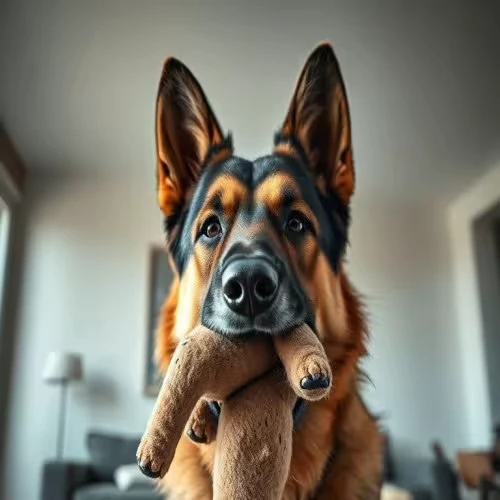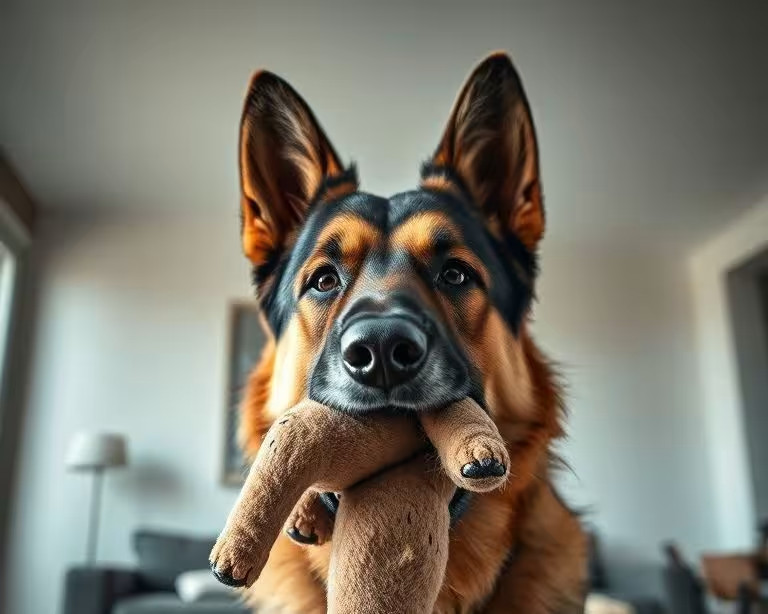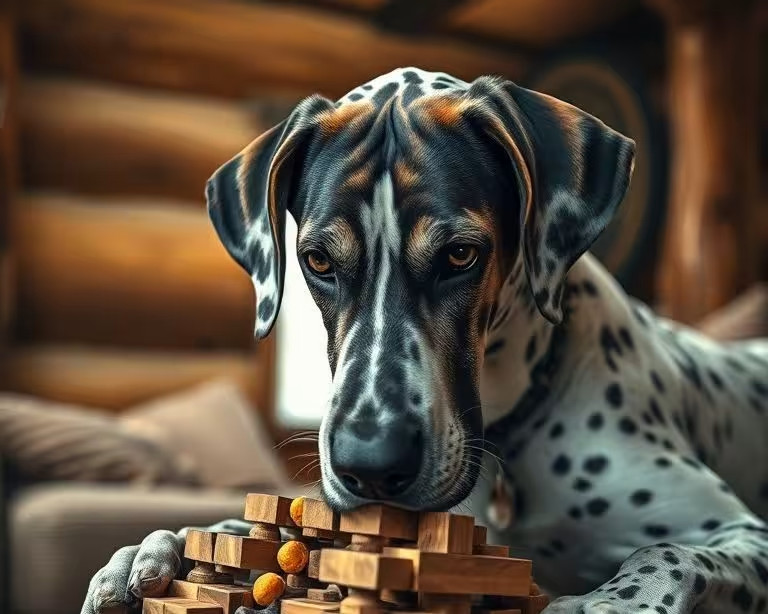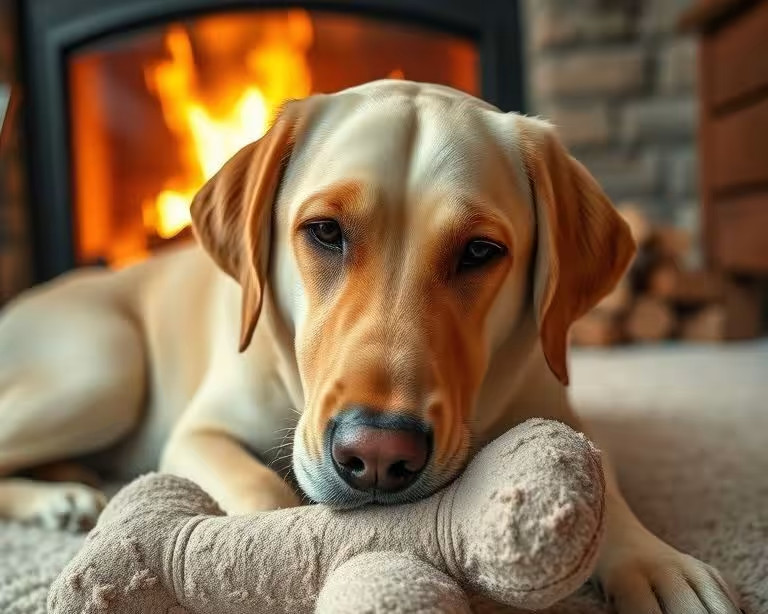The Ultimate Guide to Interactive Dog Toys for Large Breeds: Engaging Minds, Building Bonds

For owners of large dog breeds, the quest for the perfect toy is a serious endeavor. These magnificent companions possess boundless energy, incredible strength, and often, an intelligence that demands constant stimulation. Generic toys simply won't cut it; they're quickly demolished or swiftly ignored. This comprehensive guide, informed by extensive research and expert insights, is dedicated to helping you navigate the vast world of interactive dog toy for large breeds. We'll delve into the specific needs of powerful chewers and intelligent problem-solvers, explore solutions for separation anxiety, and even address the delicate requirements of teething puppies. Our goal is to empower you with the knowledge to select toys that not only withstand rigorous play but also foster mental enrichment and strengthen the incredible bond you share with your canine friend.
Understanding the Unique Needs of Large Breeds
Large dog breeds, such as German Shepherds, Great Danes, Labradors, and Rottweilers, come with distinct characteristics that heavily influence their toy requirements. Their powerful jaws, often capable of exerting hundreds of pounds per square inch (PSI) of pressure, necessitate toys made from exceptionally durable materials. Beyond physical strength, many large breeds are highly intelligent and thrive on mental challenges. Without adequate stimulation, boredom can quickly set in, leading to destructive behaviors like inappropriate chewing, excessive barking, or digging.
The Power and Purpose of Interactive Dog Toys
Interactive dog toys are more than just playthings; they are essential tools for promoting a dog's overall well-being. For large breeds, these toys serve multiple critical purposes:
- Mental Stimulation: They challenge a dog's cognitive abilities, encouraging problem-solving and preventing boredom. This is especially vital for intelligent breeds.
- Physical Exercise: While some interactive toys are primarily mental, many also involve physical activity, helping to burn off excess energy.
- Behavioral Regulation: By providing an appropriate outlet for natural instincts like chewing, foraging, and hunting, interactive toys can redirect destructive behaviors into positive channels.
- Bonding: Certain interactive toys, particularly tug or fetch toys, facilitate engaging play sessions between dog and owner, strengthening their relationship.
- Anxiety Reduction: For dogs prone to stress or separation anxiety, interactive toys can provide a comforting distraction and a sense of purpose during periods of loneliness.
Interactive Dog Toy for Large Breeds: Durability Meets Engagement
Finding an interactive dog toy for large breeds that can withstand their enthusiasm while simultaneously providing mental stimulation is the holy grail for many owners. Durability is paramount; a toy that disintegrates in minutes is not only a waste of money but can also pose a choking hazard. Look for toys constructed from robust, non-toxic materials designed for heavy chewers.
- Puzzle Toys: These are fantastic for engaging a large dog's mind. They often require the dog to manipulate parts, push levers, or roll the toy to dispense treats. For large breeds, choose puzzle toys with larger components that are difficult to swallow and made from tough plastics, wood, or dense rubber that can withstand gnawing.
- Durable Chew Toys: While not always "interactive" in the traditional sense, tough chew toys provide essential oral stimulation and can be made interactive by stuffing them with treats or peanut butter. Materials like natural rubber (e.g., KONG Extreme), reinforced nylon (e.g., Nylabone Power Chew), or even robust, non-splintering woods are excellent choices.

Caption: Even the toughest toys can eventually succumb to a powerful chewer like this German Shepherd. Regular inspection and timely replacement are crucial for safety.
- Tug Toys: Tug-of-war is an excellent way to provide physical exercise and bond with your large dog, provided it's played safely and correctly. Choose tug toys made from strong, woven ropes or durable rubber that can withstand immense pulling force without fraying or breaking. Always ensure the toy is long enough to keep your hands safely away from your dog's mouth.
- Interactive Feeders/Slow Feeders: These toys turn mealtime into a game, slowing down rapid eaters and providing a mental challenge. For large breeds, look for larger capacity feeders made from heavy-duty, food-grade plastics or stainless steel.
Interactive Puzzle Toys for Large Dogs: Keeping Minds Sharp and Boredom at Bay
Interactive puzzle toys for large dogs are arguably the most effective tools for mental enrichment. They tap into a dog's natural foraging instincts and reward persistence and problem-solving. Beyond mere entertainment, these toys offer profound benefits for your dog's cognitive health and overall behavior.
Benefits of Puzzle Toys:
- Cognitive Enhancement: Regularly solving puzzles keeps your dog's brain active, which can help prevent cognitive decline as they age.
- Boredom Reduction: By providing a constructive outlet for their energy and intelligence, puzzle toys drastically reduce the likelihood of destructive behaviors stemming from boredom.
- Stress and Anxiety Relief: The focused activity required for puzzle-solving can be incredibly calming for anxious dogs, diverting their attention from stressors.
- Slow Eating: Many puzzle toys double as slow feeders, preventing bloat and improving digestion by making your dog work for each bite.
- Independence: Puzzle toys allow your dog to entertain themselves, fostering a sense of independence and reducing over-reliance on human interaction for entertainment.
Choosing the Right Difficulty:
Start with simpler puzzles and gradually increase the complexity as your dog masters them. Observing your dog's frustration levels is key; a toy that's too difficult can lead to disinterest, while one that's too easy won't provide adequate stimulation.

Caption: Great Danes, like many large breeds, excel at complex interactive puzzle toys for large dogs, demonstrating remarkable intelligence and focus.
Dog Toys for Separation Anxiety: Providing Comfort and Distraction
Separation anxiety can be a distressing experience for both dogs and their owners. Dog toys for separation anxiety are designed to provide a comforting presence and a stimulating distraction during your absence, helping to alleviate stress and reduce destructive behaviors. The key is to introduce these toys before you leave and ideally, only make them available when you are away, so they become special, high-value items.
Choosing the Right Toys for Anxious Dogs:
- Long-lasting Chew Toys (Stuffed): A durable, stuffable chew toy (like a KONG) filled with frozen peanut butter, yogurt, or wet food can keep an anxious dog occupied for a significant period. The act of licking and chewing is inherently soothing.
- Puzzle Feeders: Similar to stuffed chew toys, puzzle feeders provide mental engagement and a rewarding experience, diverting attention from your departure. Ensure the treats are high-value to maintain interest.
- Scent-Enriched Toys: While less common, some toys can be infused with calming scents (e.g., lavender, dog-appeasing pheromones). Alternatively, leaving an item with your scent (like an old t-shirt) can provide comfort, though this isn't an "interactive toy."
- Comfort Toys: A soft, familiar toy that carries your dog's scent or has been part of their routine can offer a sense of security. Some dogs find comfort in plush toys, especially if they are durable enough not to be destroyed quickly.

Caption: A comfort toy, like this plush bone, can provide a sense of security and a calming outlet for chewing, especially beneficial for dogs with separation anxiety.
Dog Toys for Medium-Large Breeds: Finding the Perfect Fit
While much of the advice for large breeds applies, dog toys for medium-large breeds (e.g., Border Collies, Australian Shepherds, smaller Labradors) require a nuanced approach. These breeds still possess considerable strength and intelligence but might not need the absolute maximum durability of toys designed for giant breeds or extreme chewers.
Considerations for Medium-Large Breeds:
- Size and Weight: Toys should be appropriately sized for their mouth to prevent choking hazards and allow for comfortable carrying and manipulation. A toy too large might be ignored, while one too small could be swallowed.
- Durability vs. Flexibility: Opt for toys made from robust materials that can resist chewing and tearing, but also offer some flexibility or give, which can be more satisfying for their bite pressure.
- Material Safety: Always prioritize non-toxic, food-grade materials. Ensure there are no small, easily detachable parts that could be ingested.
- Interactive Features: These breeds benefit immensely from mental stimulation. Puzzle toys, snuffle mats, and treat-dispensing balls are excellent choices.
Toys for Teething Puppies: Gentle Relief for Growing Jaws
Teething is a challenging phase for any puppy, and large breed puppies are no exception. Their rapidly developing jaws need appropriate outlets for chewing to relieve discomfort and prevent damage to household items. Toys for teething puppies must be gentle on their sore gums yet durable enough to withstand sharp puppy teeth.
Ideal Teething Toys:
- Soft Rubber Toys: Toys made from softer, pliable rubber (often specifically labeled for puppies) are perfect. They provide satisfying resistance without being too hard on sensitive gums. Freezing these can offer additional soothing relief.
- Rope Toys: While caution is needed with older dogs and rope toys (due to potential ingestion of strands), for teething puppies, supervised play with sturdy rope toys can help massage gums and aid in loosening baby teeth.

Caption: A durable rope toy can be an excellent outlet for a teething puppy's urge to chew, providing both gum relief and engaging play.
- Frozen KONGs or Other Stuffable Toys: Filling a KONG with puppy-safe purees (e.g., pumpkin, unsweetened applesauce, wet puppy food) and freezing it provides a long-lasting, cooling, and soothing chewing experience.
- Nylabone Puppy Chews: Nylabone offers specific lines of chew toys designed for puppies, with softer materials than their adult counterparts, providing a safe and satisfying chewing experience.
- Wet/Frozen Washcloths: A simple, clean wet washcloth twisted and frozen can be a surprisingly effective and soothing teething aid.
Top Interactive Dog Toy Brands for Large Breeds: A Data-Driven Comparison
Based on extensive research into durability, engagement, and user satisfaction among large breed owners, here's a comparison of leading interactive dog toy options. We focus on categories and brands that consistently receive high marks for meeting the rigorous demands of powerful chewers and intelligent minds.
1. KONG Extreme Series (e.g., KONG Extreme, KONG Wobbler)
- Material: Ultra-durable, natural black rubber, designed for the toughest chewers. Food-grade and non-toxic.
- Chew Rating: Highest chew rating in the KONG line; virtually indestructible for most large breeds.
- Interactive Mechanism: Stuffable design for treats/food (KONG Extreme), or treat-dispensing wobble/roll (KONG Wobbler). Encourages licking, foraging, and problem-solving.
- Average Price Range: $15 - $35, depending on size and specific product.
- User Rating Trends: Consistently 4.5-5 stars for durability and effectiveness in keeping dogs occupied.
- Pros: Exceptional durability, versatile (can be stuffed, frozen, played with), provides long-lasting mental stimulation, excellent for separation anxiety.
- Cons: Can be challenging to clean thoroughly, some dogs may lose interest once treats are gone if not refilled.
2. West Paw Zogoflex Toys (e.g., Tux, Toppl, Hurley)
- Material: Proprietary Zogoflex material, a highly durable, non-toxic, BPA-free, latex-free, and phthalate-free thermoplastic elastomer. Recyclable.
- Chew Rating: High durability; excellent for moderate to heavy chewers, though not always "indestructible" for the most extreme power chewers. Backed by a one-time replacement guarantee.
- Interactive Mechanism: Tux and Toppl are stuffable and can be interlocked for increased difficulty. Hurley is a classic fetch and chew stick. All are floatable.
- Average Price Range: $15 - $30.
- User Rating Trends: 4-5 stars, highly praised for durability, versatility, and being gentler on gums than some harder nylon toys.
- Pros: Very durable, non-toxic, floatable, dishwasher safe (easy to clean), recyclable, excellent for stuffing and mental enrichment.
- Cons: May not withstand the absolute most aggressive chewers (e.g., pit bulls with strong bite force), can be expensive.
3. Nina Ottosson by Outward Hound Puzzle Toys (e.g., Dog Brick, Dog Worker)
- Material: Food-safe plastic composites, some with wood-look finishes. Designed for mental challenge, not heavy chewing.
- Chew Rating: Low to moderate. These are primarily puzzle toys and should be supervised to prevent chewing damage.
- Interactive Mechanism: Multi-step puzzles requiring dogs to slide, lift, or remove pieces to uncover treats. Available in various difficulty levels.
- Average Price Range: $20 - $60, depending on complexity.
- User Rating Trends: 4-5 stars for mental stimulation and engagement. Users emphasize supervision.
- Pros: Outstanding for mental stimulation, wide range of difficulty levels, helps slow down eating, excellent for building confidence and problem-solving skills.
- Cons: Not chew-proof; requires owner supervision, can be expensive for higher difficulty levels.
4. GoughNuts Chew Toys (e.g., Original, Maxx)
- Material: Extremely durable, multi-layered natural rubber. Designed by polymer engineers.
- Chew Rating: Among the highest available. Specifically designed for power chewers. Features a red inner indicator layer – if visible, the toy should be replaced.
- Interactive Mechanism: Primarily a durable chew toy, but its unique shape and weight can make for engaging fetch and retrieve games. The safety indicator is an interactive feature for the owner.
- Average Price Range: $25 - $45.
- User Rating Trends: 4.5-5 stars, consistently praised as "indestructible" by owners of aggressive chewers.
- Pros: Unparalleled durability, safety indicator provides peace of mind, floats, made in the USA, excellent for extreme chewers.
- Cons: Not a "puzzle" toy; primarily for chewing. Can be heavy. Higher price point.
Maintaining a Rotating Toy Collection for Sustained Engagement
Even the best interactive toys can lose their appeal if they're constantly available. To keep your large dog engaged and excited, implement a toy rotation strategy.
- Novelty is Key: Don't put all your dog's toys out at once. Keep a selection of 3-5 toys available and rotate them every few days or once a week. When an old toy reappears, it will feel new and exciting again.
- Introduce New Challenges: Periodically introduce a new type of puzzle or a different texture of chew toy to keep their minds stimulated and prevent boredom.
- Seasonal Swaps: Consider having different toys for indoor versus outdoor play, or for different seasons (e.g., floatable toys for summer, more robust chew toys for winter).
Safety First: Supervising Playtime and Toy Maintenance
No matter how durable a toy claims to be, constant supervision is crucial, especially for large breeds.
- Regular Inspection: Before and after each play session, inspect toys for damage, loose parts, or excessive wear. Even small cracks can become weak points.
- Replace Damaged Toys: Immediately discard and replace any toy that shows signs of significant wear, cracking, or breaking. Ingested pieces can cause serious internal injuries.
- Appropriate Sizing: Always ensure the toy is too large for your dog to swallow whole. When in doubt, size up.
- Cleanliness: Regularly clean interactive toys, especially those used with food. Follow manufacturer instructions, or use warm, soapy water and rinse thoroughly. This prevents bacterial growth and keeps the toys appealing.
Frequently Asked Questions (FAQ) About Interactive Dog Toys for Large Breeds
Q1: How often should I introduce new interactive toys to my large dog?
A1: Rather than constantly buying new toys, a more effective strategy is to rotate your dog's existing collection. Keep about 3-5 toys accessible at a time and swap them out weekly. This makes "old" toys feel new again. Introduce genuinely new toys every 1-3 months, or when you notice your dog has completely mastered their current puzzles.
Q2: My large dog destroys every toy. Are there truly indestructible interactive toys?
A2: While no toy is 100% indestructible for every dog, some brands come very close, especially for large breeds. Look for toys from the KONG Extreme line, GoughNuts, or West Paw's Zogoflex series. These are specifically engineered for power chewers using highly durable, dense materials. Remember to always supervise and choose toys labeled for "extreme chewers."
Q3: Can interactive toys really help with my large dog's separation anxiety?
A3: Yes, interactive toys can be a significant aid in managing separation anxiety, but they are often part of a larger behavioral modification plan. Toys that provide long-lasting engagement, like a KONG stuffed with frozen treats or a complex puzzle feeder, can distract your dog during your absence, associate your departure with a positive experience, and provide a calming outlet for their energy. The key is to make these toys only available when you leave, making them high-value items.
Q4: What's the best way to clean interactive puzzle toys?
A4: Most plastic or rubber puzzle toys can be cleaned with warm, soapy water and a bottle brush to reach crevices. Rinse thoroughly to remove all soap residue. Some, like West Paw's Zogoflex toys, are dishwasher safe (top rack). Wooden puzzles should be wiped clean with a damp cloth and allowed to air dry completely to prevent warping or mold. Always check the manufacturer's instructions for specific cleaning guidelines.
Q5: My large dog seems to lose interest in puzzle toys quickly. What can I do?
A5: Several factors could be at play. First, ensure the treats you're using are high-value and irresistible to your dog. Second, the toy might be too easy or too difficult. Try a more challenging puzzle if they solve it too quickly, or a simpler one if they get frustrated. Third, vary the types of puzzles (e.g., sliding, lifting, rolling) to keep things novel. Finally, rotate toys to maintain interest.
Q6: Are "dog toys for medium-large breeds" significantly different from those for large breeds?
A6: The primary difference lies in the balance of size, weight, and extreme durability. While medium-large breeds still need durable toys, they might not require the absolute toughest materials designed for giant breeds or extreme power chewers. Toys for medium-large breeds should be appropriately sized for their mouths to prevent choking and ensure comfortable play, often being slightly smaller or lighter than those for very large breeds. The focus on mental stimulation remains equally important.
Q7: What are the safest materials for interactive toys, especially for heavy chewers?
A7: For heavy chewers, look for toys made from:
- Natural Rubber: Dense, non-toxic, and durable (e.g., KONG, GoughNuts).
- Thermoplastic Elastomers (TPE): Highly durable, flexible, and non-toxic (e.g., West Paw Zogoflex).
- Reinforced Nylon: Tough and long-lasting, often used in Nylabone products. Ensure it's designed not to splinter.
Avoid toys with small, easily detachable parts, or those made from brittle plastics or inferior rubber that can break off and be ingested.
Conclusion
Investing in the right interactive dog toy for large breeds is an investment in their happiness, health, and well-being. By understanding their unique needs for durability and mental stimulation, and by carefully selecting toys that challenge their minds and satisfy their natural instincts, you can prevent boredom, reduce anxiety, and foster a deeper, more enriching relationship. Remember to prioritize safety, rotate your toy collection, and always supervise playtime to ensure your beloved companion enjoys every moment of their interactive adventures. Choose wisely, play often, and revel in the joy of a happy, engaged, and well-adjusted large dog.

 By
By
This is exactly what I need for my GSD! For the 'powerful chewers' section, are there any specific brands or materials you'd recommend that can truly stand up to that kind of jaw strength without being ingested? I'm tired of buying toys that last only an hour.
Thank you for exploring this guide on interactive toys for large breeds. Remember, the two most critical takeaways are selecting toys for extreme durability to ensure safety and longevity, and prioritizing mental enrichment to keep your intelligent companion engaged and prevent boredom-related issues. Always consult your veterinarian for personalized advice, especially regarding any behavioral concerns or specific toy suitability for your dog's unique health needs. Your vet is a crucial partner in your dog's well-being!
My Labrador suffers from separation anxiety, and I'm always looking for ways to keep her mentally engaged when I'm gone. Could you point me towards the interactive toys that are best for extended solo play to combat that 'boredom leading to destructive behaviors' issue?
My sweet Lab is so intelligent, and it breaks my heart to see her bored. I've seen firsthand how 'boredom can quickly set in, leading to destructive behaviors.' This guide gives me hope that I can find toys that truly challenge her mind and keep her happy, not just busy.
Finally, an article that truly gets the challenges of large breed ownership! The mention of 'hundreds of pounds per square inch' for jaw pressure really validated my struggles with finding durable toys for my Rottweiler. It's clear this guide is backed by solid research.